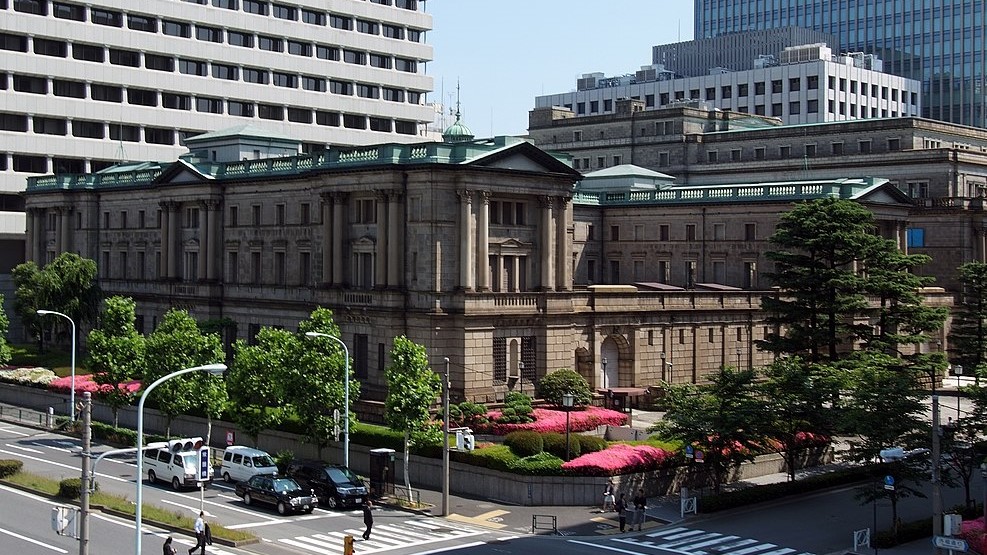 The Bank of Japan headquarters in Nihonbashi, Chūō-ku, Tokyo. For almost three decades now, the Bank of Japan has been trying to get the Japanese economy back on the road to success with its low interest rate policy—an endeavor that has so far been unsuccessful. (Image: wiiii/Wikimedia Commons)
The Bank of Japan headquarters in Nihonbashi, Chūō-ku, Tokyo. For almost three decades now, the Bank of Japan has been trying to get the Japanese economy back on the road to success with its low interest rate policy—an endeavor that has so far been unsuccessful. (Image: wiiii/Wikimedia Commons)
A policy of low interest rates, as pursued by the ECB, is detrimental to the economy in the long term, and it affects the standard of living. Young people, small banks, and many others are feeling the effects, as German economist Gunther Schnabl from Leipzig University explains in an interview with Stefan Beig. Schnabl focuses on the example of Japan, which has not been able to get away from low interest rates for thirty years now. The German economics professor, who has also been a speaker at the Austrian Academy twice, analyzes the consequences of the low interest rate policy on Japan’s once dynamic economy in even greater detail in his latest book, Japans Banken in der Krise: Folgen von 30 Jahren Niedrigzinspolitik [Japan’s Banks in Crisis: Consequences of 30 Years of Low Interest Rate Policy].
Thirty years ago, Japan veered into a low-interest-rate policy; since the late 1990s, Japan has been pursuing a de facto zero-interest-rate policy. Did that reduce prosperity?
In Japan, this is very clear. Productivity gains are the prerequisite for wage increases and the expansion of the welfare state. If productivity gains are low or even negative, wages come under pressure. Wage levels in Japan have been falling since 1998. Likewise, the real return on savings has been negative for a long time. Wealth is decaying. In a rapidly aging society, more and more people (including retirees) have to enter the workforce to limit households’ loss of wealth.
The country is stuck in a deep stagnation. There is now talk of three lost decades.
Why did Japan veer into a low interest rate policy?
In the mid-1980s, the U.S. had forced Japan to strongly appreciate the yen. This plunged the export-dependent country into a deep crisis, which the Bank of Japan combated with sharp interest rate cuts. The low interest rates developed into a bubble on the stock and real estate markets, the bursting of which triggered a new crisis in the early 1990s. As stock and real estate prices fell sharply, Japanese banks suffered from high levels of bad loans. The Bank of Japan tried to help the country out of the crisis with ever lower interest rates and extensive purchases of government bonds and stocks. But to no avail. The country is stuck in a deep stagnation. There is now talk of three lost decades. Debt has risen to about 260% of GDP and the Bank of Japan’s balance sheet is growing faster and faster because it is buying so many government bonds.
Europe and the U.S. began pursuing low interest rate policies 15 years later than Japan. Was that for similar reasons?
Yes, the European Central Bank and the Federal Reserve System cut interest rates sharply in response to the bursting of the dotcom bubble (2000). That led to the U.S. mortgage market boom, as well as consumer and housing bubbles in some southern European countries and Ireland. The bursting of these bubbles was the starting point for the U.S. mortgage market crisis as well as for the European financial and debt crises, which were fought with cheaper and cheaper money. In Europe, this led to Japanese-style stagnation in southern Europe and fueled an export and real estate bubble in Germany. Financial markets in the U.S. also recovered quickly after 2008. Then in March 2020, lockdown measures triggered new financial crises that were quickly covered up with much more money. To me, this looks like it could portend the Japanization of the entire eurozone and the USA.
The increasingly loose monetary policy pursued by the Bank of Japan over the decades has squeezed interest margins, and thus the interest surpluses of Japanese banks, ever further.
How did the central bank’s extremely low interest rate affect commercial banks in Japan?
Traditionally, the most important activities of most Japanese banks were lending and investments in government bonds. The banks lived on the difference between deposit rates on the one hand, and higher lending rates or higher interest rates on government bonds on the other. The increasingly loose monetary policy pursued by the Bank of Japan over the decades has squeezed interest margins, and thus the net interest income of Japanese banks, ever further. The lack of income could only be partially compensated by higher fees and the sale of financial products.
Did commercial banks have to change their business model?
The business model described above applied in particular to the small and medium-sized banks that granted loans to small and medium-sized enterprises and households. Since the Japanese financial crisis in 1998, demand for credit has faltered despite increasingly loose monetary policy, and the Bank of Japan has been buying up a lot of government bonds, so banks have had to focus more on selling financial products. In this area, however, the advantage goes to the large Japanese city banks, which have formed large financial conglomerates with investment banks. The small- and medium-sized regional banks and credit unions were thus forced into a painful cost-cutting process. They have had to cut staff, close branches, and merge. Even anti-trust law was ultimately suspended as a result.
Did this have consequences for the entire economy?
In bank-based economies like Japan’s (and Europe’s, too), the banking sector has an important function in granting loans. Banks decide which investment projects are financed and which are not. In order to be able to effectively assess credit risks, they maintain close relationships with local companies. This has long contributed to high growth in Japan. The Bank of Japan increasingly disrupted this process from the 1980s onward, resulting in the weakening of the country’s once impressive growth potential.
Overall economic productivity gains have also continued to fall, and growth has been consistently weak.
What has been the long-term impact of the low interest rate policy on Japan’s economy?
I would say it has been crippling. On the one hand, the Bank of Japan was able to help stabilize the economy in the short term with low interest rates and extensive purchases of government bonds and securities. However, as a result of extremely favorable financing conditions and continued wage restraint on the part of the unions, Japanese companies’ drive for greater efficiency and innovation has steadily declined. Overall economic productivity gains have also continued to fall, and growth has been consistently weak. Moreover, consumer price inflation was consistently low, while permanently high capital exports fueled asset price bubbles abroad. As a result, international financial crises such as the Asian crisis (1997/98) or the U.S. mortgage market crisis (2007-2010) have repeatedly had a severe impact on Japan.
It is primarily the young people, especially the less qualified, who lose out. Entry-level wages are falling … buying a home is becoming much more difficult.
When interest rates are low, savers and creditors are not happy about it. Are they the only losers in the medium term? Who else loses?
First and foremost, young people lose out, especially the less qualified. Wage levels at the start of working life are falling. As low interest rates drive up real estate prices—especially in metropolitan areas where there are still plenty of jobs available—buying a home becomes much more difficult. Those who move from the countryside to urban centers face high rents. Due to low incomes, many young Japanese no longer venture into the “marriage market” and stay with their parents. Because they do not start families, they are branded as parasite singles. This exacerbates the problem of a rapidly aging society.
Another often cited consequence of loose monetary policy is the growing number of zombie companies. Is this rise demonstrable in Japan—or in Europe now, too?
There is no clear definition of zombie companies. Zombie companies are often defined as companies that can no longer service their loans adequately. From my standpoint, the decisive factor is that many companies have become dependent on persistently low interest rates. In addition, the poor economic outlook in Japan has been used to constantly demand wage restraint from the unions. Both factors have sustained the profits of many companies. The Japanese zombie companies are therefore sitting on a large cushion of equity that they are not using for investment due to the dismal growth expectations. A similar situation can be observed in Europe.
Since the ongoing loose monetary policy is harmful ... I advise calling on politicians to end the money glut in the interest of the younger generation.
What do you recommend to the “normal” citizen in view of low interest rates? Should they replace their savings account with other forms of investment?
The right thing to do would have been to swap savings account deposits for real estate, shares, gold, or bitcoin ten years ago. A home of one’s own is still a very good retirement provision. However, now asset prices have risen sharply, and future developments are uncertain. If monetary policies remain expansionary, then further price increases in real assets, including art and classic cars, can be expected. However, if monetary policies are tightened—which would actually be necessary—then significant price declines can be expected. Since the ongoing loose monetary policy is harmful, not least because of the negative growth and distribution effects, I advise calling on politicians to end the money glut in the interest of the younger generation.
Europe is lagging behind the development in Japan by about 15 years. What developments could still lie ahead for Europe in view of Japan?
The real interest rate on risk-free bank deposits and on government bonds is already negative and is likely to become even more negative in view of the expected rise in inflation. I also expect real wages to fall, as in Japan. It is still uncertain whether this will be via downward pressure on nominal wages—if the crisis persists—or through a sustained rise in inflation. The persistently loose financing conditions are increasingly leading to structures like those that prevailed in socialist planned economies, because companies are increasingly dependent on the state. F.A. Hayek noted that the loss of economic freedom is sooner or later also associated with the loss of personal freedoms. For this reason alone, an exit from the money glut would be advisable.
The longer the low, zero, and negative interest rate policy continues, the greater will be the loss of prosperity.
What should be done to leave the low interest rate policy?
The longer the low, zero, and negative interest rate policy continues, the greater will be the loss of prosperity. But there is also no such thing as having your cake and eating it too. My first advice would be to immediately end the central banks’ purchases of government bonds and credibly announce market-based reforms. If the central banks signal that they are no longer willing to finance all additional government spending, then the current growth-damaging regulatory glut will also be curbed. Thereafter, asset holdings on central bank balance sheets could be cautiously reduced and interest rates increased. The accompanying restoration of market economy principles would help to brighten growth prospects and, consequently, individuals’ personal prospects.
This interview first appeared in the Austrian online medium eXXpress.
Translation from German by Thomas and Kira Howes.



